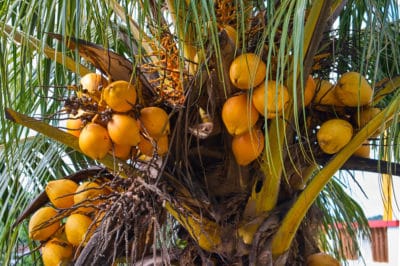Basic Description
Gardeners have choices in tall and dwarf cultivars of coconut palms, though they all have the same basic looks and habits of growth.
- The vast majority of coconut palms average 50 to 60 feet tall, with dwarf types averaging about half that height.
- Trunks are smooth with gray bark and depending on the type, are straight or slightly curved.
- Fronds are evergreen, greenish-yellow in color, with pinnately compound leaves and fronds about 15 feet long.
- In springtime, branchlets form that contain white male and female flowers.
- After flowering, small, green, oval fruits form and eventually develop into coconuts.
Cultural Requirements
Those living in USDA zones 10 and 11, as well as the warmest locations in zone 9, can successfully grow coconut palms. They will not tolerate a prolonged freeze and the tree can die. The palm is salt-, drought-, and wind-tolerant, so it grows quite well planted directly along beach areas. Surface roots are not a problem.
- Plant in a sunny location.
- Tolerates a wide range of well-drained soil types from clay to sand, and even withstands periodic flooding.
Gardener Tip: If an unexpected freeze is expected in your area, water the ground around the coconut palm well to saturate the roots the day before. The water helps insulate the roots and keep them warm.
How to Plant a Coconut Palm
When selecting a site to plant your coconut palm, take into consideration its mature height. Choose a location where the tree won’t interfere with structures and where falling coconuts won’t damage vehicles or people. If you live in hurricane-prone areas, you don’t want to plant where the coconuts turn into wind-driven bombs that can damage windows or your house.
- Remove all weeds and grasses from the planting site, clearing an area that is at least 3 feet in diameter.
- Dig a hole that is slightly wider and deeper than the coconut palm’s root ball. It’s not recommended to amend the site with organic matter and it’s best to plant directly in native soil.
- Lift the coconut from its container and place in the hole, making sure it’s standing upright and sits at the same height it was growing in its container.
- Backfill the hole halfway with soil and firm it around the palm by tamping down with your foot. Water the hole to remove any air pockets.
- Finish filling the hole with soil and tamp down with your foot again.
- Water the area around the palm again, being sure to saturate the root system.
Water the coconut palm weekly for about 8 weeks while the root system establishes itself into the new planting site. Thereafter, you can water about every other week.
Gardener Tip: To help reduce the growth of weeds and conserve moisture in the soil, you can apply a 3-inch layer of organic mulch around the planting site. Just be sure to keep the mulch several inches away from the trunk to reduce the possibility of disease and rot.
